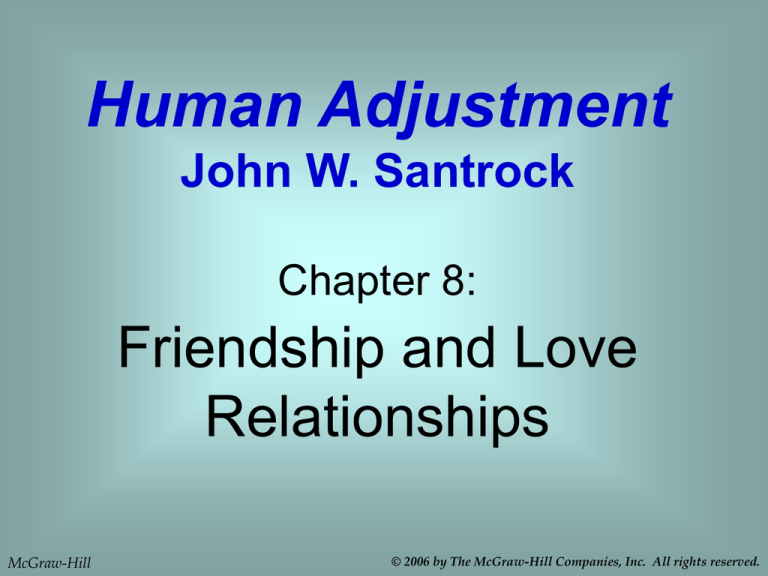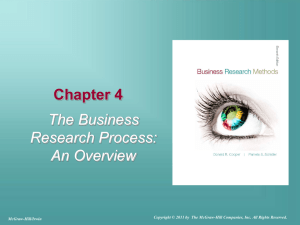
Human Adjustment
John W. Santrock
Chapter 8:
Friendship and Love
Relationships
McGraw-Hill
© 2006 by The McGraw-Hill Companies, Inc. All rights reserved.
8-2
Chapter Outline
Forming Relationships: Attraction
Friendship
Love
The Dark Side of Close Relationships
McGraw-Hill
©2006 by the McGraw-Hill Companies, Inc. All rights reserved.
8-3
Learning Goals
1. Discuss the factors involved in attraction
2. Describe friendship
3. Characterize the types of love and other factors
involved in love
4. Explain the dark side of close relationships
McGraw-Hill
©2006 by the McGraw-Hill Companies, Inc. All rights reserved.
FORMING RELATIONSHIPS:
ATTRACTION
8-4
Familiarity and Similarity
Physical Attractiveness
Personality Traits
McGraw-Hill
©2006 by the McGraw-Hill Companies, Inc. All rights reserved.
8-5
Familiarity and Similarity
Familiarity is necessary for a close relationship to
develop
– Moreland and Beach (1992) found students said they liked
women who attended class more often, even though the
targets didn’t interact with anyone
McGraw-Hill
©2006 by the McGraw-Hill Companies, Inc. All rights reserved.
8-6
Familiarity and Similarity
Similarity is also important and the people we like are
usually similar to us.
– Consensual validation - our own attitudes and behavior
are supported when someone else’s attitudes and behavior
are similar to ours
McGraw-Hill
©2006 by the McGraw-Hill Companies, Inc. All rights reserved.
8-7
Physical Attractiveness
When seeking an intimate partner, heterosexual
women rate as important in men:
– Considerateness
– Honesty
– Dependability
– Kindness
– Understanding
McGraw-Hill
©2006 by the McGraw-Hill Companies, Inc. All rights reserved.
8-8
Physical Attractiveness
Heterosexual men rate as important in women:
– good looks
– cooking skills
– frugality
McGraw-Hill
©2006 by the McGraw-Hill Companies, Inc. All rights reserved.
8-9
Physical Attractiveness
Buss (1988) found that:
– men use tactics that involve resource possession and
display (brag about cars and money, display strength)
– women use tactics that alter their appearance (wear makeup, keep well-groomed, wear stylish clothes, wear jewelry)
McGraw-Hill
©2006 by the McGraw-Hill Companies, Inc. All rights reserved.
8-10
Physical Attractiveness
Matching hypothesis = although people may prefer a
more attractive person in the abstract, in the real world,
they end up choosing someone close to their own level
of attractiveness
McGraw-Hill
©2006 by the McGraw-Hill Companies, Inc. All rights reserved.
8-11
Personality Traits
Anderson (1968) found we are attracted to people with
personality traits such as being:
– sincere
– honest
– understanding
– loyal
– truthful
– trustworthy
– intelligent
– dependable
McGraw-Hill
©2006 by the McGraw-Hill Companies, Inc. All rights reserved.
8-12
Review - Learning Goal 1
– What roles do familiarity and similarity play in attraction?
– What is the link between physical attractiveness and
attraction?
– How are personality traits related to attraction?
McGraw-Hill
©2006 by the McGraw-Hill Companies, Inc. All rights reserved.
8-13
FRIENDSHIP
The Benefits of Friendship
Gender and Friendship
McGraw-Hill
©2006 by the McGraw-Hill Companies, Inc. All rights reserved.
8-14
The Benefits of Friendship
Friendships = close relationships that involve intimacy,
trust, acceptance, mutual liking, and understanding
Benefits of friendship include:
– can reduce loneliness
– be source of self-esteem
– provide emotional support
McGraw-Hill
©2006 by the McGraw-Hill Companies, Inc. All rights reserved.
8-15
Gender and Friendship
In friendships between women, women
– have close friends
– are likely to listen and be sympathetic
– share their thoughts and feelings
In friendships between men, men are more likely to
engage in activities and show more competition
In friendships between women and men, problems
arise because of different expectations
McGraw-Hill
©2006 by the McGraw-Hill Companies, Inc. All rights reserved.
Adjustment Strategies
for Getting and Keeping Friends
8-16
1. Be nice, kind, and considerate
2. Be honest and trustworthy
3. Respect others
4. Provide emotional support
McGraw-Hill
©2006 by the McGraw-Hill Companies, Inc. All rights reserved.
8-17
Review - Learning Goal 2
– What is friendship? What are the benefits of friendship?
– What role does gender play in friendship?
McGraw-Hill
©2006 by the McGraw-Hill Companies, Inc. All rights reserved.
8-18
LOVE
What is love?
Attachment
Gender and Love
Falling Out of Love
McGraw-Hill
©2006 by the McGraw-Hill Companies, Inc. All rights reserved.
8-19
What Is Love?
Liking involves
– Similarity
– positive evaluation of another person
Loving involves:
– being close to someone
– dependency
– a self-less orientation
– absorption and exclusiveness
McGraw-Hill
©2006 by the McGraw-Hill Companies, Inc. All rights reserved.
8-20
Romantic Love
Romantic love (passionate love) = type of love that
has strong components of sexuality and infatuation,
and often predominates in the early part of a love
relationship
McGraw-Hill
©2006 by the McGraw-Hill Companies, Inc. All rights reserved.
8-21
Romantic Love
Romantic love includes intermingling of emotions:
– fear
– anger
– sexual desire
– joy
– jealousy
McGraw-Hill
©2006 by the McGraw-Hill Companies, Inc. All rights reserved.
8-22
Affectionate Love
Affectionate love (companionate love) = type of
love that occurs when individuals desire to have the
other person near and have a deep, caring affection
for the person
In a love relationship, the early stage of romantic love
grows into affection
McGraw-Hill
©2006 by the McGraw-Hill Companies, Inc. All rights reserved.
8-23
Affectionate Love
Affectionate love includes:
– secure attachment
– familiarity
– a deeply caring relationship
McGraw-Hill
©2006 by the McGraw-Hill Companies, Inc. All rights reserved.
8-24
Consummate Love
Consummate love - in Robert Sternberg’s view, the
strongest form of love that consists of:
– passion (sexual attraction)
– intimacy (emotional feeling of closeness)
– commitment (cognitive appraisal of relationship)
McGraw-Hill
©2006 by the McGraw-Hill Companies, Inc. All rights reserved.
8-25
Consummate Love
Sternberg argues passion, intimacy, and commitment
can combine to form various patterns of love:
– infatuation
– affectionate love
– fatuous love
– consummate love
McGraw-Hill
©2006 by the McGraw-Hill Companies, Inc. All rights reserved.
8-26
Figure 8.4 Sternberg’s Triangle of Love
McGraw-Hill
©2006 by the McGraw-Hill Companies, Inc. All rights reserved.
8-27
Attachment
Quality of romantic relationship is linked with quality of
our attachment (emotional bond) to caregivers such as
our parents during infancy and childhood
– Romantic partners give us secure base to return to and
obtain comfort from in stressful times
– We learn an attachment style as infants and use it as a
model for adult relationships
McGraw-Hill
©2006 by the McGraw-Hill Companies, Inc. All rights reserved.
8-28
Attachment Styles
Mary Ainsworth (1979) identified three attachment
styles between infants and caregiver:
– Secure attachment style (70%) - caregiver is responsive
to infant’s needs; infant trusts caregiver
– Avoidant attachment style (20%) - caregiver is distant or
rejecting; infant suppresses desire to be close to caregiver
– Ambivalent attachment style (10%) - caregiver is
inconsistently available and overbearing with affection;
infant clings anxiously to caregiver and then fights against
closeness by pushing away
McGraw-Hill
©2006 by the McGraw-Hill Companies, Inc. All rights reserved.
8-29
Links Between Attachment in Childhood and
Close Relationships in Adulthood
Cindy Hazan and Phillip Shaver (1987) examined
continuity between childhood attachment and romantic
relationships
– Securely attached infants are more likely to have a secure
attachment to adult romantic partner
– Individuals with avoidant attachment style in childhood find
it difficult to develop intimate relationship in adulthood
Individuals can revise attachment styles in adulthood
McGraw-Hill
©2006 by the McGraw-Hill Companies, Inc. All rights reserved.
8-30
Gender and Love
Men conceptualize love more in terms of passion
Women think of love more in terms of friendship
Women are more expressive and affectionate than
men in marriage
Women disclose more to romantic partners
McGraw-Hill
©2006 by the McGraw-Hill Companies, Inc. All rights reserved.
8-31
Falling Out of Love
Falling out of love may be wise if you are:
– obsessed with a person who betrays your trust
– involved with someone who is draining you emotionally or
financially
– desperately in love with someone who does not return
feelings
McGraw-Hill
©2006 by the McGraw-Hill Companies, Inc. All rights reserved.
Adjustment Strategies
for Breaking the Bonds of Love
8-32
1. Identify feelings that make it hard to end the
relationship
2. Develop a stronger sense of self-esteem and
independence
3. Recognize self-defeating thoughts that prevent us
from taking effective actions to leave the relationship
4. Fall in love with someone else when you are
emotionally ready
McGraw-Hill
©2006 by the McGraw-Hill Companies, Inc. All rights reserved.
8-33
Review - Learning Goal 3
– What forms does love take?
– Does our attachment to our parents in childhood shape our
relationships as adults?
– How is gender linked to love?
– What factors are involved in falling out of love?
McGraw-Hill
©2006 by the McGraw-Hill Companies, Inc. All rights reserved.
THE DARK SIDE OF
CLOSE RELATIONSHIPS
8-34
Anger
Jealousy
Spouse and Partner Abuse
Dependence
Loneliness
McGraw-Hill
©2006 by the McGraw-Hill Companies, Inc. All rights reserved.
8-35
Anger
Driscoll (2002) identifies three cyclic patterns of anger
in close relationships:
– Anger justifies itself - you make arguments to justify your
anger and then use these arguments to fuel further anger
– Passivity and outburst - your resentment builds as a result
of failure to confront problems and then anger bursts out
– Catharsis (perceived injustice) your partner’s anger makes
you angry, which makes your partner angry all over again
McGraw-Hill
©2006 by the McGraw-Hill Companies, Inc. All rights reserved.
8-36
Anger
Carol Tavris (1989) provides suggestions to break cycle
of anger:
– Stop thinking you will rescue your partner
– Assume responsibility for your emotions and actions
– Civility is important
McGraw-Hill
©2006 by the McGraw-Hill Companies, Inc. All rights reserved.
8-37
Jealousy
Jealousy = fear of perceived possibility of losing
someone else’s exclusive love
Jealousy emerges when there is a challenge to the
relationship
– Men tend to show sexual jealousy
– Women are upset at emotional infidelity
McGraw-Hill
©2006 by the McGraw-Hill Companies, Inc. All rights reserved.
8-38
Jealousy
Jealous individuals tend to idealize their partner and
underestimate their own worth
Overcoming jealousy involves reducing feelings of
insecurity and thinking more rationally about the
relationship
McGraw-Hill
©2006 by the McGraw-Hill Companies, Inc. All rights reserved.
8-39
Spouse and Partner Abuse
Anger and jealousy can lead to spouse or partner
abuse
Spouse/partner abuse affects one in four couples
McGraw-Hill
©2006 by the McGraw-Hill Companies, Inc. All rights reserved.
8-40
Spouse and Partner Abuse
Walker (2000) described a three-phase cycle of
domestic violence:
1. tension building
2. acute battering incident
3. loving-contrition
McGraw-Hill
©2006 by the McGraw-Hill Companies, Inc. All rights reserved.
8-41
Spouse and Partner Abuse
Obstacles to change in batterers:
– they minimize and deny amount of violence
– they are dependent on spouse as source of intimacy and
support
– they have low self-esteem
– they were socialized with violence
McGraw-Hill
©2006 by the McGraw-Hill Companies, Inc. All rights reserved.
8-42
Dependence
An excessively dependent person is perceived as a
burden by the partner
– The partner feels resentment and hostility
Excessively dependent people have low self-esteem
and feelings of insecurity
McGraw-Hill
©2006 by the McGraw-Hill Companies, Inc. All rights reserved.
Adjustment Strategies
for Overcoming Excessive Dependence
8-43
1. Admit the problem exists
2. Explore the reasons for such neediness
3. Initiate strategies that lead to increased
independence
McGraw-Hill
©2006 by the McGraw-Hill Companies, Inc. All rights reserved.
8-44
Loneliness
People who do not interact with others in close
relationships may feel lonely
Chronic loneliness is linked with impaired physical and
mental health
Men blame themselves for being lonely
Women blame external factors for their loneliness
McGraw-Hill
©2006 by the McGraw-Hill Companies, Inc. All rights reserved.
8-45
Loneliness and Life’s Transitions
Loneliness can occur with life transitions, such as:
– moving
– divorce
– death of friend or family member
– first year of college
At the beginning of college life, 75%
said they felt lonely at least part
of the time
McGraw-Hill
©2006 by the McGraw-Hill Companies, Inc. All rights reserved.
8-46
Loneliness and Technology
Technology might be contributing to loneliness
– link between television-viewing and loneliness
– Internet may increase social disengagement
For some, the Internet may help overcome loneliness
McGraw-Hill
©2006 by the McGraw-Hill Companies, Inc. All rights reserved.
Adjustment Strategies
for Reducing Loneliness
8-47
1. Participate in activities you can do with others
2. Be aware of early warning signs of loneliness
3. Draw a diagram of your social network
4. Engage in positive behaviors when you meet new
people
5. See a counselor or read a book on loneliness
McGraw-Hill
©2006 by the McGraw-Hill Companies, Inc. All rights reserved.
8-48
Review - Learning Goal 4
– What are some characteristics of anger in close
relationships?
– What are the sources of jealousy?
– What is the nature of spouse and partner abuse?
– What characterizes overdependence in a close
relationship?
– What factors are involved in loneliness?
McGraw-Hill
©2006 by the McGraw-Hill Companies, Inc. All rights reserved.










